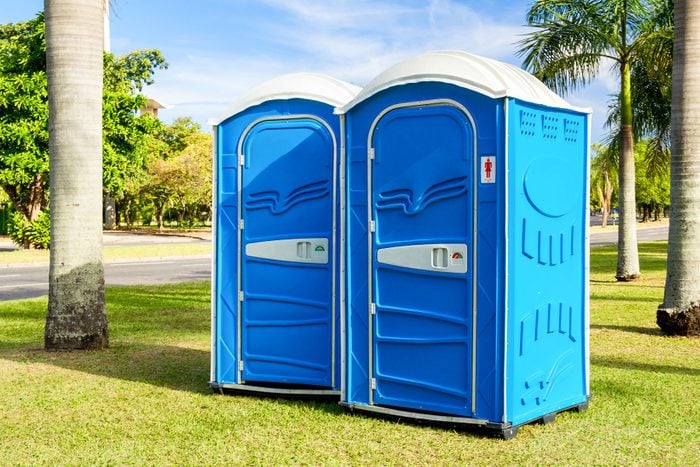How Much Does It Cost to Rent a Port-a-Potty?
Updated: Apr. 19, 2024

From backyard parties to formal job sites, here's how to rent and successfully use port-a-potties without raising a stink.
The first time I rented a port-a-potty, I was working as a production manager on a music video shoot. It was quite the scene, full of flashy Mexican cowboy (vaquero) outfits and sweeping desert scenery. All was going well until it came time to serve lunch. That’s when I realized you shouldn’t put a port-a-potty next to the food tent.
I learned my lesson that day. On dozens of subsequent film sets, I brought in all kinds of portable toilets. Here’s what to know if you’re planning on renting port-a-potties for a wedding, party, job site or other event.
On This Page
How Do Port-a-Potties Work?
Most of us are familiar with the basic portable restroom: a pit-style toilet with a direct, open hole to the waste holding tank. But there are other options for port-a-potties (aka porta johns or honey pots), depending on your situation.
Types of port-a-potties include:
- Standard or single-stall: The most economical, these usually feature a corner urinal and hand sanitizer. Sometimes these also include a sink.
- Double stall: Separate stalls for men and women. More commonly rented for open houses and company functions.
- Premium: A little larger than standard or double stall, these often include a mirror, shelf and/or coat hanger.
- Deluxe: Often include a hands-free sink and flushable toilet.
- ADA-compliant: Wheelchair-accessible entry, larger interior space, handrails and ADA-height toilet. These are also good for parents who need to accompany kids. Some even feature a baby-changing table.
- Restroom trailers: More like a regular bathroom. They come in varying degrees of luxury, including flushing toilets, house-style sinks, climate control, lighting and sometimes showers.
Other options might include antifreeze and heaters for really cold weather; wheels for easier mobility; lights for evening events; and lift hooks for cranes in case you need to move it around a job site.
Models without running water often use a blue liquid deodorizer in the holding tank to keep it smelling fresh. In the past, this included formaldehyde, but recently more environmentally and health-friendly alternatives have been developed and deployed.
All port-a-potties need to be cleaned regularly and pumped via a service truck, or emptied at the rental store.
How Many Port-a-Potties Do I Need?
In general, the rental company will recommend an appropriate amount, depending on the number of people at the event and its duration.
If it’s a three-hour backyard birthday party with 20 people, you’ll probably just need one. But if you’re throwing a six-hour wedding reception with 200 guests, you might need three or four. If it’s a festival with a lot of alcohol consumption going on, that number might increase further to avoid lines at the stalls.
Construction sites have their own rules, dictated federally by the U.S. Occupational Safety and Health Administration (OSHA). They require one toilet for every 15 employees, then another for every additional 20 employees.
But on larger sites, it’s common to have one toilet for every 10 employees, reducing the use of each toilet to maintain a cleanlier experience. Also, state and local authorities may have additional requirements for job sites.
How Much To Rent a Porta Potty?
It’s generally more expensive to rent port-a-potties during the summer and in more populated areas, because both situations create a higher demand. Price also depends on the duration of the rental. Most companies offer discounts for renting by the week or month, versus just for a day or two.
Prices vary widely, but commonly it’s $150 to $250 per week for a standard unit, up to more than $1,000 for a luxury restroom trailer. You might also have to pay additional fees for delivery and cleaning/emptying services.
Do I Need a Permit for a Port-a-Potty?
It depends on your state and city regulations.
If you’re just having a party in your backyard or on private property, chances are you won’t need one. If you’re setting up in a public park, you might need a permit for the event and the port-a-potty placement. On job sites, permits often are required, but fall under the overall construction permit.
How Often Do Port-a-Potties Need to Be Cleaned/Maintained?
It depends on the number of people using it, but typically once a week.
“A weekly service includes a deep clean, where our technician will empty the fecal matter and liquid from the toilet, clean the inside of the unit with a cleaning agent, refill the toilet with water and the deodorizer, and restock the unit,” says Taelor Preheim with PortaPros in Boise, Idaho. “Don’t be afraid to request cleanliness in a toilet!”
How Can I Be a Good Port-a-Potty Steward?
Remember, a port-a-potty is a shared space like any other public restroom. It’s up to everyone to be respectful by keeping it clean for other users and the cleaning staff.
“As an industry, there is a stigma, which usually is attached to a joke,” says Preheim. “One thing I love to remind people is that our employees often work long hours and take pride in knowing customers will have a clean place to go. The job is demanding, so please take a moment to share your appreciation and leave a review. It truly makes an impact!”
